Camera grid lines are powerful tools to elevate your photography. Apply the Rule of Thirds for balanced compositions, create symmetry by centering subjects, and align horizons in landscapes. Use diagonals for dynamic shots and emphasize leading lines to guide the viewer's eye. Perfect architectural shots by aligning building edges, and improve portraits by positioning eyes on the upper third. Enhance food photography with strategic placement, and master minimalist techniques by emphasizing negative space. Don't forget to frame subjects creatively and experiment with different angles. These simple yet effective techniques will transform your images from amateur to professional-looking. Discover how to access the full potential of your camera's grid lines.
Apply the Rule of Thirds
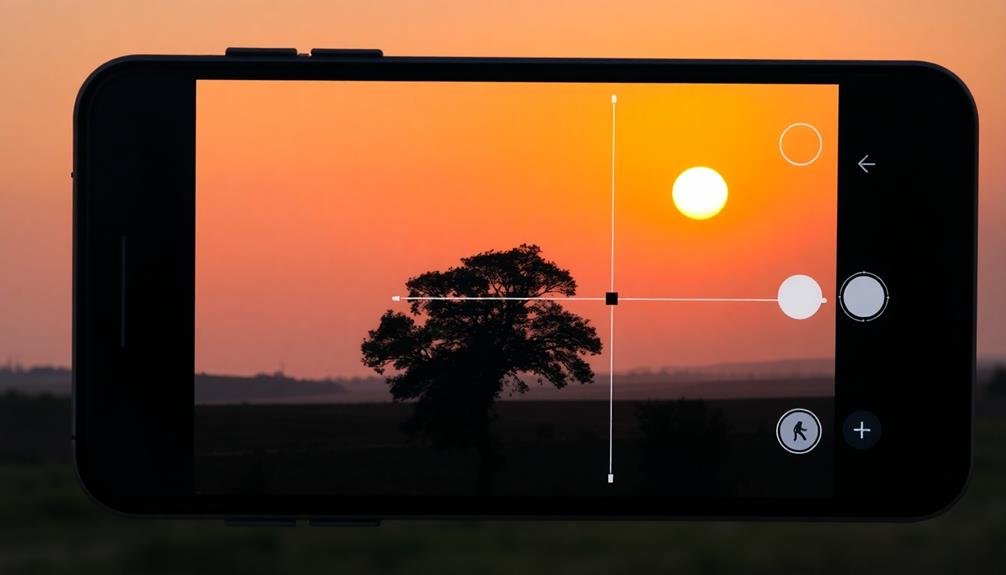
How can you instantly improve your photo composition? Apply the rule of thirds using your camera's grid lines. This technique divides your frame into nine equal parts with two horizontal and two vertical lines. It's a powerful tool that helps you create more balanced and interesting images.
To use the rule of thirds effectively, place your main subject along these lines or at their intersections. These points naturally draw the viewer's eye and create a sense of balance.
For landscapes, align the horizon with one of the horizontal lines rather than centering it. This adds depth and interest to your shot.
When photographing people, position their eyes along the upper horizontal line. This creates a more engaging portrait that connects with viewers.
For action shots, leave space in front of your moving subject by placing them on the opposite third of the frame.
Don't be afraid to break this rule occasionally. Sometimes, centering your subject can create a powerful image.
However, mastering the rule of thirds will give you a solid foundation for composing compelling photos. Practice using your camera's grid lines, and you'll soon find yourself instinctively creating more visually appealing images.
Create Symmetrical Compositions
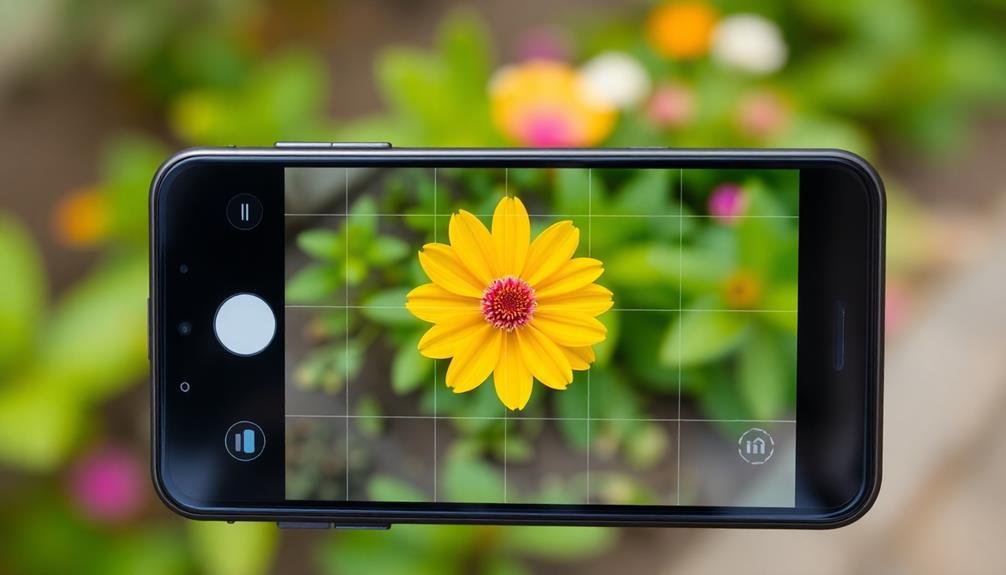
While the rule of thirds helps create dynamic compositions, symmetry offers a different approach to visual harmony. Camera grid lines are invaluable tools for achieving perfect symmetry in your photos. By aligning key elements with the center grid line, you can create visually striking and balanced images.
To create symmetrical compositions:
- Position your main subject in the center of the frame.
- Align vertical or horizontal elements with the grid lines.
- Guarantee equal spacing on both sides of the central line.
Look for naturally symmetrical subjects like reflections in water, architectural features, or patterns in nature. When photographing buildings, use the grid to keep vertical lines straight and centered. For portraits, align the subject's eyes with the horizontal center line.
Remember that symmetry doesn't always mean exact mirroring. You can create near-symmetrical compositions by balancing similar elements on either side of the frame. This approach adds interest while maintaining a sense of order.
Experiment with different types of symmetry, such as rotational or radial symmetry, to add variety to your images. By mastering symmetrical compositions, you'll expand your creative toolkit and capture visually compelling photos that draw the viewer's eye.
Align Horizon for Landscape Shots
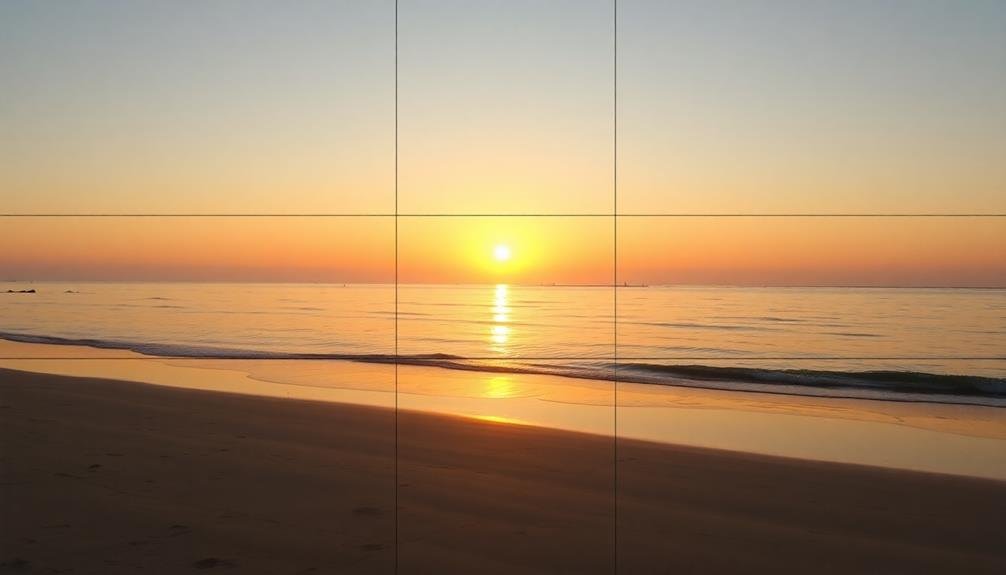
Few elements can ruin a landscape photo faster than a crooked horizon. That's where camera grid lines come to your rescue. By using the horizontal grid lines, you'll easily align your horizon, ensuring your landscapes look polished and professional.
To start, enable the grid feature in your camera settings. Most cameras offer a 3×3 grid, which is perfect for this purpose.
Once activated, use the top or bottom horizontal line as a guide for your horizon. If you're shooting a seascape, align the horizon with the bottom line to emphasize the sky.
For landscapes with interesting foreground elements, use the top line to showcase more of the ground.
Frame Subjects With Diagonal Lines
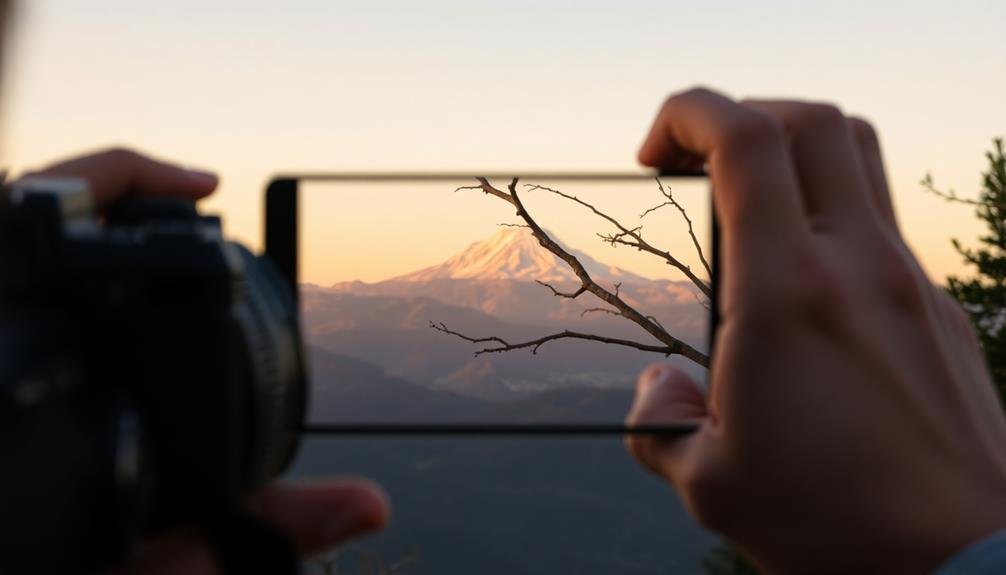
Diagonal lines in photography inject dynamism and energy into your images. When using camera grid lines, you can leverage diagonals to create compelling compositions that guide the viewer's eye through the frame. By aligning your subject along these diagonal lines, you'll create a sense of movement and depth that draws attention to the main focal point.
To effectively frame subjects with diagonal lines:
- Look for natural diagonals in your environment, such as staircases, roads, or architectural elements.
- Position your subject at the intersection of diagonal grid lines.
- Use the rule of thirds grid to create diagonal compositions by placing your subject off-center.
Don't be afraid to tilt your camera to create diagonal lines where they don't naturally exist. This technique can add visual interest to otherwise static scenes.
Remember that diagonal lines can lead the eye in different directions, so consider where you want your viewer's gaze to travel within the image. By mastering the use of diagonal lines in your compositions, you'll create more engaging and visually striking photographs that captivate your audience and elevate your photography skills.
Emphasize Leading Lines in Scenes

Leading lines are powerful compositional tools that can transform your photographs from ordinary to extraordinary. When using camera grid lines, you can easily identify and emphasize these natural or man-made lines in your scenes. Look for roads, rivers, fences, or architectural elements that draw the viewer's eye into the image.
Align these leading lines with your grid to create a strong visual path. Use the rule of thirds grid to position the lines along the vertical or horizontal thirds, guiding the viewer's gaze to your main subject. Alternatively, employ the diagonal grid to emphasize dynamic leading lines that cut across the frame.
Experiment with different perspectives to make the most of leading lines. Get low to the ground to exaggerate a path stretching into the distance, or climb to a higher vantage point to capture winding roads or rivers.
Don't be afraid to use multiple leading lines to create depth and interest in your composition.
Balance Multiple Subjects in Frame
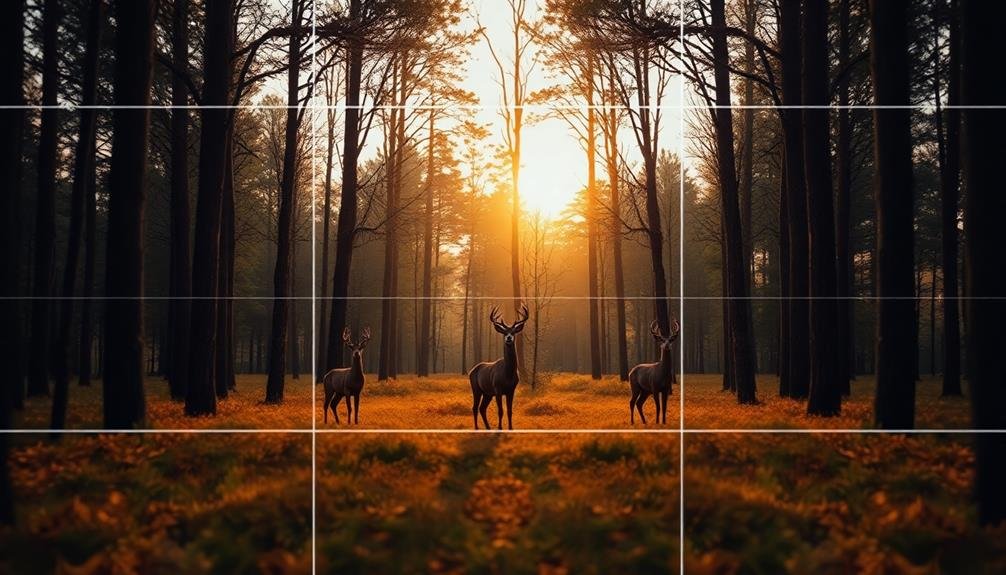
While leading lines guide the viewer's eye, balancing multiple subjects in a frame creates visual harmony and interest. Using camera grid lines, you'll find it easier to position your subjects for a well-balanced composition. The rule of thirds is particularly useful here, as it provides a framework for placing multiple elements within your image.
When you're working with two subjects, try placing them on opposite intersections of the grid lines. This creates a sense of balance and tension between the elements. For three or more subjects, distribute them across different grid intersections or along the lines themselves.
Remember these key points when balancing multiple subjects:
- Use negative space to give your subjects room to breathe
- Consider the visual weight of each element
- Experiment with asymmetrical balance for a more dynamic composition
Don't be afraid to break the rules occasionally. Sometimes, intentionally unbalancing your composition can create a striking effect.
As you practice, you'll develop an intuitive sense of balance in your images. Keep experimenting with different arrangements until you find the most visually appealing composition for your scene.
Capture Perfect Architectural Shots

When shooting architecture, you'll find grid lines invaluable for creating striking compositions.
Use vertical grid lines to perfectly align building edges, ensuring your structures appear straight and well-balanced in the frame.
For symmetrical buildings or facades, position key elements along intersecting grid lines to highlight the architectural design's harmony and proportions.
Align Vertical Building Lines
One of the most effective ways to capture stunning architectural shots is by aligning vertical building lines with your camera's grid. This technique helps create a sense of balance and symmetry in your images, making them more visually appealing and professional-looking.
When you're photographing tall structures, it's essential to keep the vertical lines perfectly straight to avoid distortion and maintain the building's integrity.
To align vertical building lines using your camera's grid:
- Enable the grid feature in your camera settings
- Position yourself directly in front of the building
- Adjust your camera angle until the vertical lines of the structure align with the grid lines
As you frame your shot, pay attention to the edges of the building and verify they're parallel to the grid lines on both sides.
If you're using a wide-angle lens, be aware that it might introduce some distortion, especially at the edges of the frame. In this case, you may need to adjust your position or use post-processing techniques to correct any remaining distortion.
Frame Symmetrical Architectural Elements
Symmetry in architecture can create visually stunning compositions, and your camera's grid lines are the perfect tool to capture these balanced elements. When framing symmetrical structures, align the central vertical grid line with the building's axis of symmetry. This technique guarantees that equal parts of the structure appear on both sides of the frame, highlighting its balanced design.
Use the horizontal grid lines to position key architectural features. For instance, place the horizon or the building's base along the bottom horizontal line, and align ornate details or the roofline with the top line. This approach creates a visually pleasing balance within your image.
| Architectural Element | Grid Line Placement |
|---|---|
| Central axis | Vertical center line |
| Building base | Bottom horizontal |
| Roofline | Top horizontal |
| Doorways | Intersecting points |
Don't forget to experiment with different perspectives. Try positioning your camera at various angles and distances to find the most impactful composition. You can also use the rule of thirds grid to place focal points at intersecting lines, drawing attention to specific architectural details while maintaining overall symmetry.
Improve Portrait Composition Instantly

When shooting portraits, you'll find grid lines especially useful for employing the Rule of Thirds.
Position your subject's eyes along the upper horizontal line or at one of the intersecting points for a more engaging composition.
You can also use the grid to create a frame within a frame, placing your subject within natural or architectural elements to add depth and context to your portrait.
Rule of Thirds
The rule of thirds is a fundamental principle in photography that can instantly elevate your portrait compositions. It involves dividing your frame into a 3×3 grid and placing key elements along these lines or at their intersections. This technique creates a more balanced and visually appealing image, drawing the viewer's eye to the most important parts of your photo.
To effectively use the rule of thirds in portrait photography:
- Position your subject's eyes along the upper horizontal line
- Align the body or face along one of the vertical lines
- Place points of interest at grid intersections
When framing your shot, avoid centering your subject. Instead, place them slightly off-center using the grid lines as a guide.
This creates negative space that adds depth and interest to your composition. You'll find that this simple adjustment can dramatically improve the overall impact of your portraits.
Frame Within Frame
Creating a frame within a frame is a powerful technique to instantly elevate your portrait compositions. This method involves using elements in your scene to create a secondary frame around your subject, drawing the viewer's attention and adding depth to your image.
To achieve this effect, look for natural frames like doorways, windows, arches, or tree branches. Position your subject within these elements, using your camera's grid lines to align them perfectly. You'll want to guarantee the frame doesn't overwhelm your subject but rather complements and enhances their presence.
Experiment with different types of frames. Architectural features often provide strong, geometric shapes, while natural elements can create softer, organic frames. Consider the balance between the frame and your subject, adjusting your composition to maintain focus on the person you're photographing.
Pay attention to lighting when using this technique. A frame can create interesting shadow patterns or highlight your subject depending on its position relative to your light source.
Use your camera's grid lines to fine-tune the placement of both the frame and your subject, ensuring a harmonious and visually striking composition.
Enhance Food Photography Presentation

Food photographers, both amateur and professional, can elevate their culinary shots by skillfully employing camera grid lines. These lines serve as invaluable guides for composing mouthwatering images that draw viewers' attention and showcase dishes in their best light.
When shooting food, use the grid to align key elements along the intersections or lines. This technique helps create a balanced and visually appealing composition. Place the main dish at one of the grid's intersections, allowing supporting elements like garnishes or utensils to occupy other areas of the frame.
To enhance your food photography presentation using grid lines, consider these techniques:
- Use the rule of thirds to position the focal point of your dish.
- Align supporting elements along vertical or horizontal grid lines.
- Create diagonal lines with utensils or ingredients to add dynamism.
Don't forget to experiment with different angles. Overhead shots benefit from grid lines to guarantee plates and tableware are perfectly aligned.
For side-angle shots, use the grid to maintain straight horizons and properly position the dish within the frame. By mastering these grid line techniques, you'll consistently produce stunning food photographs that entice viewers and showcase culinary creations at their finest.
Master Minimalist Photography Techniques

While minimalist photography may seem simple at first glance, mastering its techniques requires careful attention to composition and the strategic use of camera grid lines. By leveraging grid lines, you'll enhance your ability to create striking minimalist images that captivate viewers with their simplicity and impact.
To achieve minimalist perfection, focus on these key elements:
| Technique | Grid Line Use | Impact |
|---|---|---|
| Rule of Thirds | Align subject on intersections | Creates balance |
| Negative Space | Use grids to frame empty areas | Enhances focus |
| Leading Lines | Align with horizontal/vertical grids | Guides viewer's eye |
| Symmetry | Center subject using middle grid | Creates harmony |
| Golden Ratio | Place focal point on spiral overlay | Adds visual appeal |
When composing your shot, use grid lines to isolate your subject and eliminate distractions. Experiment with different placements along the grid to create tension or harmony within the frame. Remember, minimalism isn't just about removing elements; it's about emphasizing the essential. Use your camera's grid lines to guide your composition, ensuring that every element serves a purpose in your minimalist masterpiece.
Frequently Asked Questions
How Do I Turn on Grid Lines on My Smartphone Camera?
To turn on grid lines for your smartphone camera, open your camera app and look for settings. You'll usually find a "Grid" or "Gridlines" option. Toggle it on, and you'll see lines appear on your screen when taking photos.
Can Grid Lines Be Customized or Changed to Different Patterns?
You can customize grid lines on many smartphone cameras. Check your camera app's settings for options to change patterns, colors, or overlay styles. Some apps even let you create custom grids or download additional grid templates.
Do Professional Photographers Use Grid Lines in Their Work?
Yes, many professional photographers use grid lines. You'll find they're popular for composition, especially with the rule of thirds. They're also helpful for alignment and balance. However, some pros prefer shooting without grids for creative freedom.
Are There Situations Where Using Grid Lines Might Be Detrimental?
Yes, grid lines can be detrimental when you're capturing spontaneous moments or creative compositions. They might limit your artistic vision, distract you from the subject, or make your images feel too rigid and formulaic. Trust your instincts sometimes.
How Do Grid Lines Affect Image Quality or File Size?
Grid lines don't affect your image quality or file size. They're just visual aids displayed on your camera screen or viewfinder. Once you've taken the photo, the grid lines aren't part of the final image you've captured.
In Summary
You've now got a powerful set of tools to elevate your photography. By mastering these grid line techniques, you'll transform ordinary shots into eye-catching compositions. Don't be afraid to experiment and break the rules occasionally. Remember, the grid is there to guide, not restrict. With practice, you'll develop an intuitive sense of composition that'll make your photos stand out. So grab your camera, turn on those grid lines, and start creating stunning images today!





Leave a Reply